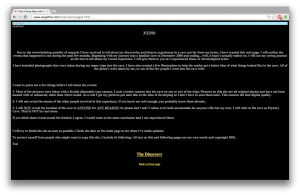
I’ve always had a certain propensity towards the things that go bump in the night. Maybe it was because of the countless summers I spent at sleep-away camp, swapping ghost stories around a dying fire; or maybe it was my father’s immense collection of HP Lovecraft that I was forbidden to read as a child (and, of course, read every chance I got). Maybe it was just an innate fascination. Whatever the reason, in the years since, my love for the horror genre has only grown. And recently, it led me to the virtual world of “Creepypasta.”
Creepypasta—an unquantifiable forum in which both amateur and professional authors create and share scary stories, has deep roots in folklore and urban legends, and seems to hold Lovecraft to the highest possible esteem—has provided a complete overhaul of the methods in which we seek fear, and seek to fear instill fear in others.
With the advent of the technologic age, and the rise of digital communication media, word of mouth has given way to word of user, or website: “These days, instead of the campfire, we are gathered around the flickering light of our computer monitors” (Wiles).
The most successful Creepypastas, in both ratings and eliciting fear, are the lengthier ones, as they rely on time-tested and true rhetorical strategies that promote user engagement. Drawing from Lovecraft’s 1927 definition of “weird” fiction, the authors of these long works know that, in order to keep the reader engaged, “A certain atmosphere of breathless and unexplainable dread of outer, unknown forces must be present; and there must be a hint, expressed with a seriousness and portentousness becoming its subject, of that most terrible conception of the human brain” (Wiles).
Two of the oldest and most respected long-form Creepypastas, “Ted the Caver,” and “BEN Drowned” artfully demonstrate how to keep the reader engaged, and guarantee that they will see the work through to the end, both utilize the same rhetorical strategies: a format that breaks from the traditional narrative and fabricated multimedia evidence.
The tale of “Ted The Caver,” in which two amateur spelunkers excavate a virgin cave, and unwittingly wake a beast of unfathomable evil, is presented as a genuine blog, with the narrator (presumably, Ted himself) chronicling the events of the story in real-time posts. “BEN Drowned,” the story of a young college student who unknowingly purchases a Majora’s Mask cartridge that is haunted by the malevolent spirit of a boy named Ben, is also written as blog post entries, each stamped in real time.

This format—a blog maintained by a clueless narrator—demands the continued interest and attention of the reader. With unnervingly realistic narrative voices and characters, the reader is constantly engaged, wondering if what they are reading is fact or fiction, pushing forward to see how the plot unravels.
In addition to format, both Creepypastas guarantee their readers’ attention throughout the duration of the piece by offering them some form of evidence, which acts as a validation for the readers’ continued commitment to the piece, a method for ensuring that they will continue reading, and a deeper level of meaning and context for the story itself. In “Ted The Caver,” Ted shares photos of the cave, and their progress in excavating it. “BEN Drowned” offers videos of the supposedly haunted section of the video game, complete with music and graphics that break from canon of the original game while still maintaining its integrity and validity. These offerings are fascinating, lend credibility to the content, and help to keep the reader engaged.
Owing to the evolution of communication as a digital medium, keeping a reader engaged until the end of a long piece can prove difficult. But by adapting to the changing rhetorical situation, such as the authors of “Ted the Caver,” and “BEN Drowned” have done with their nontraditional formats and multimedia integrations, it is not an impossible task.

WORKS CITED
Jadusable. “BEN Drowned.” Creepypasta Wiki. 7 Sept. 2010. Web. 30 Oct. 2014.
Wiles, Will. “Creepypasta: With a flood of dark memes and viral horror stories, the internet is mapping the contours of modern fear.” Aeon. 20 Dec. 2013. Web. 30 Oct. 2014.
Welcome to the Page of Ted. Angelfire. 19 May 2001. Web. 30 Oct. 2014.

Oh my gosh this is incredible! This looks like a great use of rhetorical strategy in using audience and delivery to keep their readers engaged!